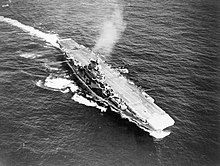Operation Banquet
| date | August 24, 1944. |
|---|---|
| place | Padang |
| output |
| Parties to the conflict | |
|---|---|
| Commander | |
| losses | |
|
1 plane |
1 freighter |
The operation Banquet was an air raid British carrier based aircraft to Padang in Japanese -occupied West Sumatra in the Pacific theater during World War II .
planning
Shortly after Admiral Somerville handed over command of the Eastern Fleet to Admiral Fraser, Rear Admiral Moody planned the operation with the primary objective of Padang and the cement works in Indaroeng , as well as the port installations in Emmahaven . The carrier-based aircraft should also be on August 23, 1944 air and sea rescue protection for Operation Boomerang des XX. Twentieth Air Force bomber commandos of Major General Curtis E. LeMay deploy to Japanese targets in Sumatra.
The Task Force 64 were the aircraft carrier Victorious and Indomitable and the battleship Howe , two cruisers and five destroyers .
On board the Indomitable were the 1836th and 1839th Naval Air Squadron with 14 Hellcats each , and the 815th and 817th Naval Air Squadron with 14 barracudas each .
The Victorious had Corsair fighter jets and torpedo bombers on board.
attack
The starting position for the attack was reached at 5:50 a.m. on the morning of August 24 under optimal weather conditions. From the two aircraft carriers, 20 barracudas took off in the first wave, accompanied by 19 Corsairs of the Victorious . The second wave started at 7:10 am with nine barracudas from the Indomitable and three from the Victorious , as well as 12 accompanying Corsairs from the Victorious. The barracudas each carried a 500 lb bomb.
The planes could not find any enemy warships in Emmahaven or Padang and all warehouses looked closed. There was also no activity at all with the loading cranes. This had already been reported by a Dutch submarine in April , but this was unknown to the British command staff.
The bombers were able to approach their targets with great precision without any Japanese counter-defense from the air and with only slight ground defense. Nevertheless, a Corsair was shot down by the Japanese.
One goal of the operation could not be achieved due to the low resistance; to carry out the intended training of the rather inexperienced, young pilots in combat practice. However, there was another success, because for the first time in a British season a Hellcat reconnaissance unit flew , which took excellent photos during the attack.
In the course of the British attacks, in addition to the damage to the port facilities and the cement works, the freighter Shiretoko Maru was sunk and the freighters Senko Maru and Chisho Maru were damaged.
Individual evidence
- ↑ Christopher Chant: The Encyclopedia of Codenames of World War II . Routledge Kegan & Paul Publishing House, 1987, ISBN 978-0-7102-0718-0 (English, codenames.info [accessed July 6, 2020]).
- ↑ a b Jürgen Rohwer: Chronicle of the Naval War 1939–1945. Württembergische Landesbibliothek Stuttgart 2007 to 2020, accessed on July 6, 2020 .
- ^ A b c David Hobbs: The British Pacific Fleet: The Royal Navy's Most Powerful Strike Force . Naval Institute Press, 2011, ISBN 978-1-59114-044-3 (English, google.de [accessed July 4, 2020]).
- ^ Robert Cressman: The Official Chronology of the US Navy in World War II . Naval Institute Press, 2016, ISBN 978-1-68247-154-8 (English, google.de [accessed July 7, 2020]).
Web links
- Thomas McKelvey Cleaver: Tidal Wave: From Leyte Gulf to Tokyo Bay . Ed .: Bloomsbury Publishing Plc. Osprey Publishing, 2019, ISBN 978-1-4728-2546-9 (English, google.de [accessed July 7, 2020]).



